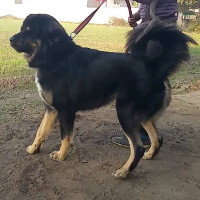Appearance of the Gaddi Kutta
|
| They come in solid colors of black and beige, dark fawn and sometimes reddish, black and white umber. Working sheepdogs are shorter and lighter than those kept as pets. The height of the male is 71 to 87 centimeters, and that of the female 66 to 81 centimeters. Males weigh between 45 and 80 kilos, and females between 35 and 60 kilos. |
Temperament of the Gaddi Kutta
|
| Due to its active nature, this breed is not designed to stay indoors for long periods or in an apartment. The Himalayan Sheepdog is normally used as a herding or guard dog, and requires a great deal of outdoor exercise. This breed may require obedience training in order to domesticate them. Training this breed can be difficult due to its independent and stubborn nature. Confidence and dominance should be imposed when training the Himalayan Sheepdog. To successfully train this breed, it's best to be strict when practicing repetitive training exercises and socializing them as puppies. Proper care of this breed includes daily exercise and training. Although this hardy breed can be prone to being ferocious towards strangers, they are loyal to their owners, making them faithful companions. As well as being vigilant and territorial, they are also affectionate and gentle towards their owners, making them suitable family pets. It is advisable to keep this breed away from other pets, as Himalayan Sheepdogs tend to be aggressive and jealous of other animals. |
Needs and activities of the Gaddi Kutta
|
| This mountain dog breed closely resembles the Tibetan Mastiff and may be related to the Tibetan longhaired Kinnaur Shepherd. Naturally, Himalayan Sheepdogs live an outdoor life and are rarely seen beyond the Indian regions. As a powerful, robust breed, the Himalayan Sheepdog is mainly used for breeding purposes. The Himalayan Sheepdog is highly prized in the region as a loyal companion and working dog. |
Maintenance of the Gaddi Kutta
|
| The life expectancy of the Himalayan Sheepdog is ten years. This breed is known to be relatively healthy due to their active lifestyles, but is also prone to a few health problems. Hip dysplasia, elbow dysplasia, patella luxation, arthritis, glaucoma and obesity are just some of the common health problems. Appropriate care for this breed includes daily exercise and training. |







 English (United Kingdom)
English (United Kingdom)